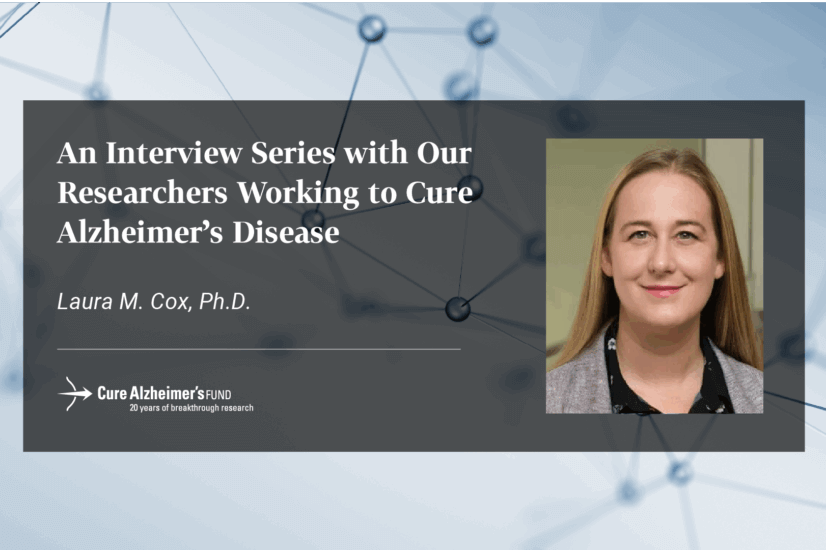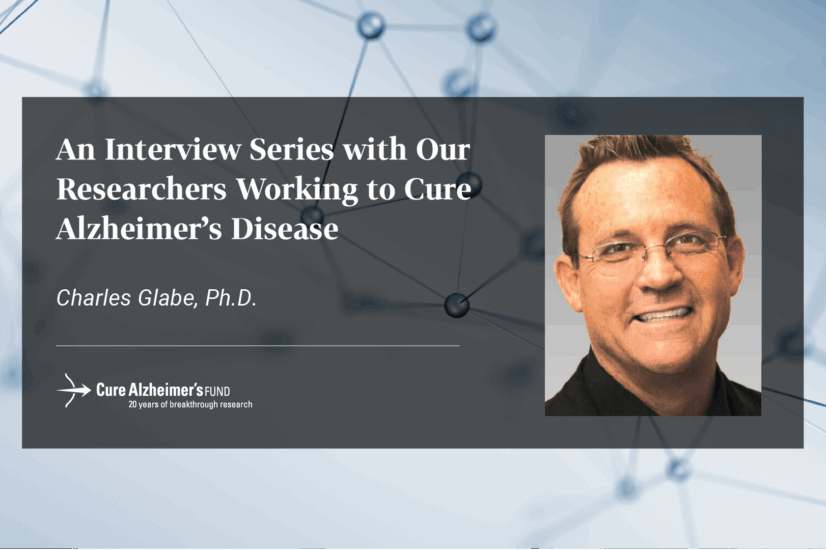At Cure Alzheimer’s Fund, one of our successful strategies is to fund research that is innovative and based on high-quality science yet deemed risky by traditional funding sources. Our entrepreneurial approach and ability to provide funds in a quick and efficient manner allows us to fund potentially groundbreaking work that otherwise might sit unpursued.
This approach is making a dramatic difference. In 2009, we reported two very successful examples of this type of leveraging by our funded researchers Robert Moir and Giuseppina Tesco. Moir’s concept that the Abeta peptide is an antimicrobial peptide, and part of the innate immune system, initially was funded by Cure Alzheimer’s Fund, and this work led to an RO1 grant, the original and histroically oldest grant mechanism from the National Institutes of Health. Cure Alzheimer’s Fund supported Tesco’s pilot studies exploring the relationship between traumatic brain injury and Alzheimer’s, which allowed her to secure an RO1 grant.
And 2010 has brought even more success, with four more leveraging examples and others in the pipeline.
Charlie Glabe from University of California, Irvine, used his CAF project on anti-oligomer monoclonal antibodies as the preliminary data to support a new NIH RO1 award of $1 million over 5 years. He used some of the antibodies he made in the CAF project to show that different types of amyloid oligomers exist and that they warrant further study to determine their role in AD. His RO1 grant will explore the structural heterogeneity of amyloid aggregates and the relationships of this conformational variation to the toxicity or pathogenic activities of amyloid oligomers.
David Holtzman at Washington University, St. Louis, explains his successful use of CAF funds:
“One of my CAF grants enabled me to gather preliminary data and publish papers that facilitated a grant application to the Ellison Medical Foundation, and within the last year, I applied for the Ellison Foundation Senior Scholar Award. The grant is related to my work on how synaptic activity regulates the Abeta peptide and the sleep/wake cycle. My application was successful and I was awarded a grant which started in October for $600,000 in direct costs over four years.”
Virginia Lee and colleagues at the University of Pennsylvania proposed an innovative way to significantly reduce Abeta levels and plaque deposition in an established mouse model of Alzheimer’s disease with their “Brain-Penetrant Thromboxane Antagonists for Alzheimer’s Disease Therapy” grant from Cure Alzheimer’s Fund. Their approach involved disrupting a particular biochemical process in which an omega 6 fatty acid that activates the thromboxane (TP) neuronal receptor in the brain stimulates excess Abeta production. Antagonists (drugs or compounds that bind to a receptor) previously used for this purpose did not successfully bridge the blood brain barrier and therefore proved ineffective. New technology suggested that novel compounds to intervene in this process also might be able to penetrate the blood brain barrier with minimal-to-no toxicity or other negative effects. The project showed considerable progress in the synthesis and evaluation of a number of TP receptor antagonists that are brain-penetrant.
This “proof of concept” work enabled the team to secure much greater funding, a five-year RO1 grant totaling more than $2.3 million from the federal government for further development of this high-potential therapeutic approach. Continuation of this work is ongoing in the drug discovery program in their Center for Neurodegenerative Disease Research.
Sam Gandy also parlayed his Oligomer Collaborative funding from Cure Alzheimer’s into a three-year Department of Veterans Affairs grant.
This type of support is a big win all around. Cure Alzheimer’s Fund grants are providing seed capital to researchers to prove a concept and then leverage start-up funding into much larger government and private grants. Stay tuned for updates and more examples.
Normal 0 false false false EN-US X-NONE X-NONE
At Cure Alzheimer’s Fund, one of our successful strategies is to fund research that is innovative and based on high-quality science yet deemed risky by traditional funding sources. Our entrepreneurial approach and ability to provide funds in a quick and efficient manner allows us to fund potentially groundbreaking work that otherwise might sit unpursued.
This approach is making a dramatic difference. In 2009, we reported two very successful examples of this type of leveraging by our funded researchers Robert Moir and Giuseppina Tesco. Moir’s concept that the Abeta peptide is an antimicrobial peptide, and part of the innate immune system, initially was funded by Cure Alzheimer’s Fund, and this work led to an RO1 grant from the National Institutes of Health. Cure Alzheimer’s Fund supported Tesco’s pilot studies exploring the relationship between traumatic brain injury and Alzheimer’s, which allowed her to secure an RO1 grant.
And 2010 has brought even more success, with four more leveraging examples and others in the pipeline.
Charlie Glabe from University of California, Irvine, used his CAF project on anti-oligomer monoclonal antibodies as the preliminary data to support a new NIH RO1 award of $1 million over 5 years. He used some of the antibodies he made in the CAF project to show that different types of amyloid oligomers exist and that they warrant further study to determine their role in AD. His RO1 grant will explore the structural heterogeneity of amyloid aggregates and the relationships of this conformational variation to the toxicity or pathogenic activities of amyloid oligomers.
David Holtzman at Washington University, St. Louis, explains his successful use of CAF funds:
“One of my CAF grants enabled me to gather preliminary data and publish papers that facilitated a grant application to the Ellison Medical Foundation, and within the last year, I applied for the Ellison Foundation Senior Scholar Award. The grant is related to my work on how synaptic activity regulates the Abeta peptide and the sleep/wake cycle. My application was successful and I was awarded a grant which started in October for $600,000 in direct costs over four years.”
Virginia Lee and colleagues at the University of Pennsylvania proposed an innovative way to significantly reduce Abeta levels and plaque deposition in an established mouse model of Alzheimer’s disease with their “Brain-Penetrant Thromboxane Antagonists for Alzheimer’s Disease Therapy” grant from Cure Alzheimer’s Fund. Their approach involved disrupting a particular biochemical process in which an omega 6 fatty acid that activates the thromboxane (TP) neuronal receptor in the brain stimulates excess Abeta production. Antagonists (drugs or compounds that bind to a receptor) previously used for this purpose did not successfully bridge the blood brain barrier and therefore proved ineffective. New technology suggested that novel compounds to intervene in this process also might be able to penetrate the blood brain barrier with minimal-to-no toxicity or other negative effects. The project showed considerable progress in the synthesis and evaluation of a number of TP receptor antagonists that are brain-penetrant.
This “proof of concept” work enabled the team to secure much greater funding, a five-year RO1 grant totaling more than $2.3
At Cure Alzheimer’s Fund, one of our successful strategies is to fund research that is innovative and based on high-quality science yet deemed risky by traditional funding sources. Our entrepreneurial approach and ability to provide funds in a quick and efficient manner allows us to fund potentially groundbreaking work that otherwise might sit unpursued.
This approach is making a dramatic difference. In 2009, we reported two very successful examples of this type of leveraging by our funded researchers Robert Moir and Giuseppina Tesco. Moir’s concept that the Abeta peptide is an antimicrobial peptide, and part of the innate immune system, initially was funded by Cure Alzheimer’s Fund, and this work led to an RO1 grant from the National Institutes of Health. Cure Alzheimer’s Fund supported Tesco’s pilot studies exploring the relationship between traumatic brain injury and Alzheimer’s, which allowed her to secure an RO1 grant.
And 2010 has brought even more success, with four more leveraging examples and others in the pipeline.
Charlie Glabe from University of California, Irvine, used his CAF project on anti-oligomer monoclonal antibodies as the preliminary data to support a new NIH RO1 award of $1 million over 5 years. He used some of the antibodies he made in the CAF project to show that different types of amyloid oligomers exist and that they warrant further study to determine their role in AD. His RO1 grant will explore the structural heterogeneity of amyloid aggregates and the relationships of this conformational variation to the toxicity or pathogenic activities of amyloid oligomers.
David Holtzman at Washington University, St. Louis, explains his successful use of CAF funds:
“One of my CAF grants enabled me to gather preliminary data and publish papers that facilitated a grant application to the Ellison Medical Foundation, and within the last year, I applied for the Ellison Foundation Senior Scholar Award. The grant is related to my work on how synaptic activity regulates the Abeta peptide and the sleep/wake cycle. My application was successful and I was awarded a grant which started in October for $600,000 in direct costs over four years.”
Virginia Lee and colleagues at the University of Pennsylvania proposed an innovative way to significantly reduce Abeta levels and plaque deposition in an established mouse model of Alzheimer’s disease with their “Brain-Penetrant Thromboxane Antagonists for Alzheimer’s Disease Therapy” grant from Cure Alzheimer’s Fund. Their approach involved disrupting a particular biochemical process in which an omega 6 fatty acid that activates the thromboxane (TP) neuronal receptor in the brain stimulates excess Abeta production. Antagonists (drugs or compounds that bind to a receptor) previously used for this purpose did not successfully bridge the blood brain barrier and therefore proved ineffective. New technology suggested that novel compounds to intervene in this process also might be able to penetrate the blood brain barrier with minimal-to-no toxicity or other negative effects. The project showed considerable progress in the synthesis and evaluation of a number of TP receptor antagonists that are brain-penetrant.
This “proof of concept” work enabled the team to secure much greater funding, a five-year RO1 grant totaling more than $2.3 million from the federal government for further development of this high-potential therapeutic approach. Continuation of this work is ongoing in the drug discovery program in their Center for Neurodegenerative Disease Research.
Sam Gandy also parlayed his Oligomer Collaborative funding from Cure Alzheimer’s into a three-year Department of Veterans Affairs grant.
This type of support is a big win all around. Cure Alzheimer’s Fund grants are providing seed capital to researchers to prove a concept and then leverage start-up funding into much larger government and private grants. Stay tuned for updates and more examples.
million from the federal government for further development of this high-potential therapeutic approach. Continuation of this work is ongoing in the drug discovery program in their Center for Neurodegenerative Disease Research.
Sam Gandy also parlayed his Oligomer Collaborative funding from Cure Alzheimer’s into a three-year Department of Veterans Affairs grant.
This type of support is a big win all around. Cure Alzheimer’s Fund grants are providing seed capital to researchers to prove a concept and then leverage start-up funding into much larger government and private grants. Stay tuned for updates and more examples.







